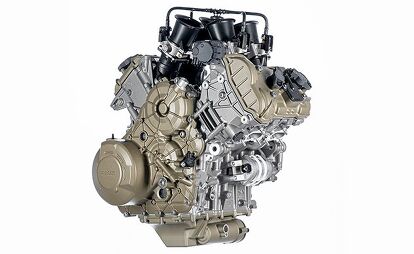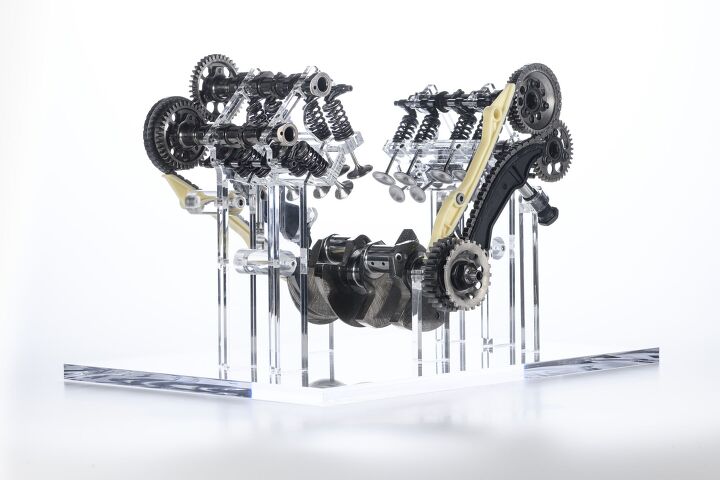All-New, All-Singing and Dancing Groundbreaking Ducati V4 Granturismo 1158
All our conjecture was resolved early this morning when Ducati CEO Domenicali unveiled the new V-Four engine that will power the next generation Ducati Multistrada. The biggest surprise is that the new “Granturismo” 1158 engine will not use desmodromic valve actuation, but regular springs. That doesn’t seem like a bad thing in this application, as it gives the engine “record-breaking maintenance intervals”– 60,000 km or just over 37,000 miles. (It’s probably an excellent thing, in fact, since the mystery and expense of having to have one’s desmodromic valves adjusted has always loomed large for the non-wealthy when contemplating Ducati ownership.)
The new engine has been developed for maximum smoothness of operation, says Ducati: “Compact and light, featuring rich torque values: an engine designed for “adventouring” use, at the same time offers great thrills and sportiness.” Not only is the new V4 a few pounds lighter than the outgoing Twin, it’s also 95mm shorter in height, 85mm shorter front to back, and only 20mm wider, which gives the chassis designers much greater leeway. Ducati claims 170 horsepower at 10,500 rpm and 92 foot-pounds of torque at 8750 rpm, which is likely to translate to around 145 horses and 80 ft-lbs of torque or so on our rear-wheel dyno. At super-high MotoGP rpm, desmodromics still makes sense. At these lower rpm levels, with modern valve springs, desmo is mainly a needlessly complex marketing tool. Full props to Ducati for being able to break with tradition.
In another break with recent desmoquattro tradition, rear-cylinder bank deactivation is going to keep this Ducati much cooler when it’s stuck in traffic. It was first used on the Streetfighter V4.
The Granturismo will make its first appearance in the new, fourth-generation Multistrada V4, to be introduced November 4. One of us will have to ride it, I suppose. Sounds like it might be a challenge to find things to criticize.
Begin Press Release:
Borgo Panigale (Bologna, Italy), October 15, 2020 – A new era begins in Borgo Panigale as Ducati presents to the public the new V4 Granturismo, the engine that will equip the long-awaited new generation of Ducati Multistrada: which is going to be shown to the world Wednesday, November 4.
An extremely compact, lightweight, high-performance, torque-rich engine designed to meet the needs required in “adventouring” use without neglecting emotion and sportiness.
Built with latest-generation technology as well as first-in-class materials available, in order to guarantee both durability and reliability, the V4 Granturismo stands out for its record-breaking maintenance intervals for a motorcycle engine and has been created as the heart of a high-performance and dynamic bike, ready to explore every corner of the planet with its owner.
The engine was presented to the public with a video (below) in which Claudio Domenicali – Ducati CEO – the engineers and technicians who followed its development reveal all its secrets and features to the Ducati enthusiasts.
Every single technical choice made during the development of the V4 Granturismo project was aimed at ensuring maximum fluidity of operation combined with a substantial extension of maintenance intervals.
The new distribution includes a spring valve return system, bringing the maintenance intervals of the V4 Granturismo to 60,000 km. This was achieved thanks to the in-depth expertise Ducati has acquired in the use of materials, treatments and technical solutions developed around the Desmodromic system. All this, applied to a spring valve return system which stresses the components less if compared to the Desmo, produced to set an outstanding milestone never set before by a motorcycle engine. In addition, the engine ensures great regularity of operation at both low revs and loads, without forgetting the outright performance, the power at high revs and the reach of an authentic sports engine: the V4 Granturismo delivers 125 kW (170 hp) at 10.500 rpm and a maximum torque of 125 Nm (12.7 Kgm) at 8.750 rpm. All this respecting the stringent Euro 5 homologation norms.
With the weight of 66.7 kg, the V4 Granturismo can boast a record lightness, being 1.2 kg lighter than the Testastretta twin-cylinder used on the previous Multistrada 1260. The 1,158 cc displacement came out as being the perfect point of connection in terms of performance, lightness and dimension of a V4 engine, capable of being incredibly light and compact. Compared to the previous generation engine, the V4 Granturismo measures 85 mm shorter, 95 mm lower and only 20 mm wider. This compact layout allowed Ducati engineers to house the engine in the frame more effectively and centrally to positively influence the position of the bike’s center of gravity, with all the resulting benefits.
The V4 Granturismo also inherits some elements derived from the experience gained by Ducati in the racing world, such as the decision to adopt a counter-rotating crankshaft, which improves the handling and agility of the bike, and to exploit the “Twin Pulse” technology, capable of offering a full-bodied and perfectly manageable power delivery at every speed.
To avoid a reduction in thermal comfort due to the heat transmitted by the rear cylinders, the V4 Granturismo adopts the strategy of deactivating the rear bank at idle. In this way, when the bike is stationary, the combustion process in the cylinders is halted and this improves the thermal comfort of the rider and passenger thanks to the reduction of the temperature while simultaneously reducing fuel consumption.
V4 Granturismo main technical data
- 1158 cc 4-cylinder 90° V engine
- Bore x stroke 83 x 53.5 mm
- Compression ratio 14:1
- Maximum power 125 kW (170 hp) at 10,500 rpm
- Maximum torque 125 Nm (12.7 Kgm) at 8,750 rpm
- Euro 5 homologation
- Distribution part chain, part gear – timing with dual overhead camshaft, 4 valves per cylinder
- Counter-rotating crankshaft with crank pins offset at 70°
- Wet multi-plate anti-patter servo clutch
- Semi-dry sump lubrication with three oil pumps: 1 delivery and 2 return
- Fueling with four oval throttle bodies (46 mm diameter equivalent)
- 6-speed gearbox with Ducati Quick Shift (DQS) Up & Down System
- 60,000 km maintenance valves interval
- Deactivating rear bank
Become a Motorcycle.com insider. Get the latest motorcycle news first by subscribing to our newsletter here.
More by John Burns















































Comments
Join the conversation
Don't mean to rain on your parades but 11 years and a measly 20 HP increase? Chains on the front and back of the engine looks like a nightmare from an old Audi A4. With every automobile that has implemented cylinder bank deactivation, there is a kit to re-enable it due to issues. I've had my 2010 since new and was hoping for more of a reason to upgrade (at least 200 HP!)
Those pictures are some real jewelry for a mechanical engineering person, or manufacturing person.